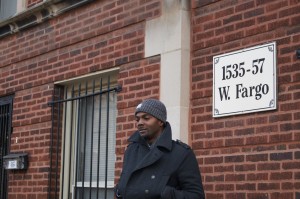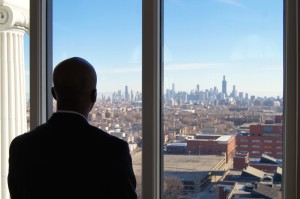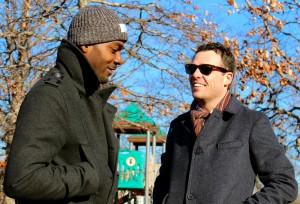
For Fred Long, Chicago’s youth-focused nonprofit UCAN has been a ticket to a world that he never even knew existed growing up on the city’s South Side.
CHICAGO — There are 31 stops between 95th Street and Jarvis on the CTA Red Line.
And Fred Long has a story for all of them.
As a native of Chicago’s Far South Side, 95th is home, while 87th was high school. When pulling into 63rd, Englewood comes to mind, while 35th signifies the White Sox, and the first sign of white faces when riding north — or the last sign while southbound. At Cermak-Chinatown, there’s a glimpse into Asia. And then there’s the Loop, where Monroe means traffic court.
“In our neighborhood, the only reason anyone I knew ever went as far as downtown was if you had to go to court,” Fred, the 36-year-old vice president of development and government affairs for Chicago youth services nonprofit UCAN, reminisced in late January while standing bundled in a gray stocking cap and coat on a frigid platform at 95th Street. “And that was a big trip for people. You had to mentally prepare yourself for that journey.”
Like many of his peers in Chicago, where today 47 percent of black men between 20 and 24 years old are both out of school and out of work, Fred’s own South Side story easily could have never extended beyond traffic court in the Loop.
But through a relationship developed as a teen with UCAN — the Chicago social services institution that for more than 150 years has helped youth who have suffered trauma become future leaders — Fred’s odyssey has stretched to an apartment on the opposite end of the Red Line in Rogers Park, and then to professional roles rubbing elbows with political elites in Springfield and Washington, D.C., and some of the wealthiest philanthropists in Chicago.
“People always talk about how something saves your life,” Fred said. “UCAN, it didn’t save my life, but it definitely changed my life. It got me out of Roseland, gave me somewhere to go to every day and put me out of harm’s way. It’s allowed me to meet people I never would have known, and experience things that I never could have imagined.”
For Fred, however, the tracks leading to where he stands today were anything but smooth.

Born in 1979 in Altgeld Gardens as the middle child of nine to a father who developed a heroin addiction while serving in the Navy during Vietnam and a mother who developed her own struggles with drug abuse during the ’80s, the odds were stacked against Fred early on.
“As a little kid, my mom would be off doing drugs, and all of us would be left alone at home, hungry and without food,” he recalled. “We’d sit there looking down the street for her — that’s called ‘Window Pain.’ Or sometimes she’d take us on drug runs, where she’d go inside a house and we’d sit in a car parked outside all day or night … We felt helpless.”
At 9 years old, with his father absent and his mother selling off the family’s belongings to support her drug habit, Fred’s maternal grandmother contacted the Illinois Department of Children and Family Services with concerns about her grandchildren. Soon after, DCFS pulled Fred and his eight siblings from their home and placed them under state protection.
“We were placed in DCFS care, and my grandma took us in at her home in Roseland — all nine of us,” Fred said. “I was the only one of my brothers and sisters who didn’t have kids before the age of 18. So growing up, there were about 20 of us at any time living in a three-bedroom, one-bathroom house.”
Cramped at home and stigmatized by classmates due to his “ward of the state” label, Fred also was feeling squeezed on the streets as each day he was forced to pass through the violent turf of the Gangster Disciples, Vice Lords and Black P. Stones just to get to and from grade school in the adjacent Pullman neighborhood.
“My family was affiliated with gangs, and if your family is affiliated then you’re grandfathered in,” he said, explaining the trepidation that he faced on a daily basis, even though he was never a gang member himself.
In the late 1980s, as the emergence of crack cocaine overwhelmed the city’s African-American neighborhoods, homicides in Chicago spiked from 660 in 1988 to 940 by 1992. It was during this time when Fred’s seventh-grade classmate, who was in a gang, was murdered by his fellow members during a dice game inside a home just down the block. Fred was compelled to make a decision for his future.
“I thought to myself, if I go to high school with those guys, I’m not going to make it.”
Seeking a haven from the dangers looming at the local high schools, Fred was accepted to Chicago Vocational, located a few miles northeast on 87th Street. The decision to attend high school in another neighborhood was a monumental one for Fred, who had never been north of 95th. But even though the school itself turned out to be safer, the daily commute was not as he was forced to take two bus trips and a ride on the “L” each way through gang turf. Eventually, his luck as an “Opp” — someone from the “opposite side” — caught up with Fred when he was jumped by a rival group on the back of a bus as it pulled up to his school.
“High school was four years of crazy torture,” Fred said.
As a sophomore, Fred was caught shooting dice on campus at Chicago Vocational and suspended. A parent-teacher conference was required for re-enrollment, but as a youth in DCFS care, Fred had no parents. And with his grandmother unable to travel — and displeased with his suspension — he was forced to sit at home for two weeks, which caused him to fail the year.
“I spent my entire junior year in a sophomore homeroom,” Fred said. “It was humiliating.”
He persevered, however, and by enrolling in summer school and hitting the books, he bounced back and was able to graduate with his class in 1997.
“That’s a feat for us,” Fred said of earning his high school diploma as a young black man growing up in Roseland. “It’s like graduating from Northwestern.”

Today in Chicago, nearly half of black men in their early 20s are unemployed, according to a recent study from the University of Illinois at Chicago’s Great Cities Institute. The challenges facing young black men on the South Side were similar in 1997 when Fred graduated from Chicago Vocational. So, when he secured a part-time job at the local Athlete’s Foot in Roseland, Fred had little expectation for a future that would bring much more. But then his DCFS case worker presented him with an opportunity.
“I was still in the system, but I was about to turn 18, and I had a conversation with my case worker who said, you know, you qualify for this Independent Living program offered through UCAN,” recalled Fred, who had never before heard of the youth organization. “I wasn’t into anything that DCFS offered.”
With a laugh, Fred continued, “But then they said that I could have my own apartment. And I was like, sign me up! Yes, that’s right, I am in DCFS. I am a ward of the state. Get me out of here!”
After a couple of interviews with state and UCAN officials downtown, Fred had apartment keys in hand and found himself in a car with his case worker, bound for a side of Chicago that he’d never seen — or imagined he would.
“We drove all the way up Lake Shore Drive to the very end, and I was like, where are we going?” Fred said. “Then we passed Loyola, and I was like, OK, this is a different environment. I’ve never been around a university.”
Eventually, the car pulled to a stop on West Fargo Avenue, on the northern end of Rogers Park, where Fred was settled into a studio apartment, and then left to start up a new life.
“I’d moved from 95th to Rogers Park. I was out of my environment, and not used to living alone,” Fred said. “It became a little scary for me. I didn’t have much ability to communicate with people different from me. I didn’t have any cable, so I’d sit at home for a while, but then I’d walk over to the Red Line [Jarvis stop] and ride all the way back to down to 95th.”

A fish out of water, it took months for Fred to even spend consecutive nights at his apartment in Rogers Park. But during the long rides back and forth on the Red Line, he began to piece the world together, platform by platform.
Addison was the Cubs and Wrigleyville revelers. Belmont was alternative lifestyles. Fullerton was DePaul. Then from North/Clybourn down to Roosevelt, it was business professionals.
“I actually started understanding the world from a train ride,” Fred said. “But there was no one to help me process it.”
Eventually, Fred made a good friend in his apartment building who had lived in UCAN’s youth home and introduced him to the many programs that the organization offered beyond Independent Living.
Through UCAN, Fred also enrolled at East-West University in the Loop, where he made the basketball team as a point guard and studied computer science. As the months passed, Fred gradually found himself becoming more comfortable in Rogers Park — and especially at UCAN’s youth facility on North Mozart Street in the Irving Park neighborhood, where he built strong relationships and learned to recognize and work through trauma, including his own.
“On the day I emancipated out of the DCFS system and Independent Living at 21,” Fred recalled, “I asked them at UCAN, can I still come here and chill out?”
After his emancipation, Fred moved back to the South Side, but not to the old neighborhood.
“By then, I had gotten used to being by myself, and Roseland was not the place for me,” he said.
With the money that he’d saved while in the Independent Living program, he paid for an apartment in Hyde Park near the University of Chicago and then secured a clerical job with Cook County Assessor’s Office in the Loop.
“That was the start of my adult life,” said Fred.
Fred, however, wasn’t destined for a career in city service.
One day a couple of years later while walking in the Loop, Fred bumped into Claude Robinson, executive vice president of diversity and external affairs at UCAN, who encouraged him to consider a new paid internship that the organization was offering.
“I had lunch with Claude a few days later,” Fred said, “and I never went back to the Cook County Assessor’s Office.”
After joining UCAN as an intern, Claude brought Fred along with him to an event held at elementary school.
“I sat back and watched the presentation to the 4th graders,” Fred recalled. “And then Claude had me speak. I explained my journey through Roseland, and the DCFS and what I was doing now.
“After I finished, they gave me a standing ovation. And I’m like, ‘What in the hell is this?’ The teacher came up and said, that’s not easy to do. But to me, it was very easy to do.”
After finishing his one-year internship, Fred accepted a full-time job in youth development with UCAN. During his early years, he launched a popular youth music program and helped develop Project Visible Man, an initiative dedicated to providing strong male role models for African-American boys, many of whom have no men at home.
“For a lot of black boys, when people tell you to be a man, it’s like telling you to be a scientist,” Fred said. “Without ever having seen one or knowing what it actually takes to become one, you just don’t know how.”
Moving from intern into youth development, over time Fred eventually worked his way into a senior leadership role as director of government affairs, making regular trips to Springfield and D.C. to lobby on behalf of the organization. Last spring, he finished his degree at Chicago State, and in August added vice president of development to his job title.

In his current position with UCAN, Fred is responsible for all private fundraising, a crucial role for the organization as public funding for social services continues to dwindle in budget-crunched Illinois. In addition to interacting with wealthy donors, he also remains dedicated to interacting with the youths living at UCAN’s new West Side campus in North Lawndale, as well other kids throughout the city who have suffered trauma.
“Fred is able to communicate and tell his story, and it’s not made up — it’s authentic,” said Thomas Vanden Berk, CEO of UCAN. “That’s extremely valuable, and why we started the process at UCAN more than 10 years ago to hire our own youth. When we have people out in the community talking to kids about overcoming violence and trauma and drug addiction, those who have been in our programs can relate so much better to them because they’ve actually lived through it.”
Today, more than a dozen other UCAN alumni like Fred are working for UCAN, helping the organization impact others in the positive ways that it impacted them while growing up.

Today, Brian Walker is a member of UCAN President’s Board and involved in its Resource Development Committee, but he vividly recalls the day more than four years ago when he was first introduced to UCAN — and Fred Long.
“When I was asked to get involved with UCAN, I wanted to meet some of the youth they served,” said Walker, CEO of Chicago-based AE Marketing Group. “I’ll never forget walking into a UCAN facility on South Damen Avenue and right away being greeted with Fred’s infectious smile.”
After spending time with the youths participating in Project Visible Man and UCAN’s other after-school programs, Walker was hooked on the organization and its mission.
“These kids live so close by,” he said of the youth that UCAN serves, “but are in a world far from the one in which my own children are growing up in the West Loop.
“As a brand guy, it was fascinating that UCAN has been around since before the Great Chicago Fire, yet most people still have never heard of it.”
Walker says that the more that people hear UCAN’s stories and see the impact that the organization has on youth in Chicago, the more he believes they’ll want to get involved.
And Chicago needs it.
In January, the city not only endured 51 murders — the most for that month since at least 2000 — but, according to data from the U.S. Census Bureau, the 47 percent rate of 20- to 24-year-old black men both unemployed and not in school is four times higher than that for white Chicago men in the same age bracket, and also far above the numbers for the same groups in New York City and Los Angeles.
Statistics such as those make support all the more vital for UCAN’s various programs dedicated to violence prevention, healing trauma, building strong families and educating and empowering youth, which directly served or impacted more than 10,000 youth and family members in Chicago in 2015.
“There are a lot of others who have had it worse than me,” said Fred, who now lives in Chicago’s Beverly neighborhood along with his wife, 11-year-old son and 6-year-old daughter. “Today, as a black man, when I meet a black boy, I understand certain dynamics without even knowing them.
“And I know that these young men need to see a black man in a suit embrace them. They need to have candid conversations. They need to build trust and relationships. When you do that, then they’ll open up and say, ‘What do you want to know, Mr. Fred?’ ”
And that’s when the train leaves the station.

UCAN helps Chicago youth who have suffered trauma become our future leaders. Each year, the social service agency provides thousands of children and families a consistent presence, meaningful programming and unrivaled diversity — with more than 94 percent of those served expressing the belief that the agency has given them opportunities to improve their future.
In 2016, UCAN will complete its new North Lawndale Campus, which will further assist some of the most underserved citizens in the city.
There are many ways that you can help UCAN make a difference in Chicago. To get involved, click here.
To read more thought leadership from AE Marketing Group, visit The Brand Lab Series™ at Medium.com.